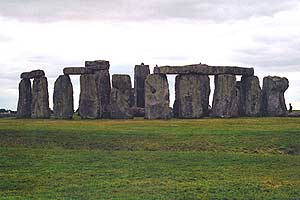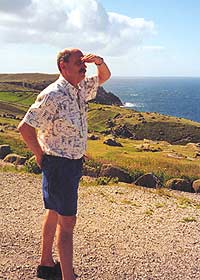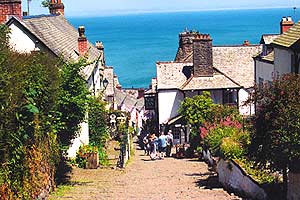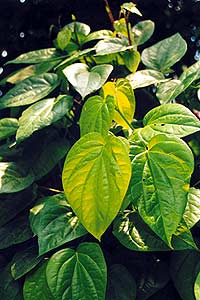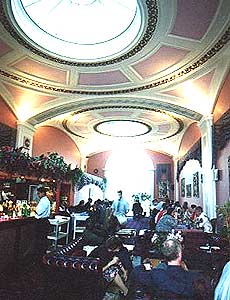by Dave DeWitt, Research and Notes by Mary Jane Wilan
Why Europe is Embracing Fiery-Foods
Part One: England Part Two Part Three
The first meal on our European trip was deliciously spicy. After we landed in London, we dropped in on Sanjay and Reena Anand, who are producers of elaborate Asian weddings. Because we had traveled with them in India, they knew we loved fired up food, so they treated us to an Indian brunch to ease our jet lag. Their cook prepared unusual chappatis, a round flat bread, with a variety of ingredients such as potatoes, cauliflower, and green onions. They were served with a marvelous yogurt and a fiery mango pickle with small, hot red chiles (or chillis, as they spell it there). The brunch climaxed with a medium-hot curried lamb that set the tone of our European tour: it was the first of many curries with no turmeric, and it suggested the oncoming food theme of the trip: the food of the former colonies heating up the former colonial powers.
After brunch, we were picked up by Pat and Dominique Chapman, who were determined to show us as much of rural England as possible in six days.
Stonehenge and Strange Signs
Pat is one of England’s foremost food experts, and is called “The King of Curries” there because he has authored dozens of books on the subjects of curries and other Indian foods. On our way to Stonehenge, he railed about what was happening to English food. On one hand, it was great that thousands of Indian, Bangladeshi, and other Asian restaurants had opened in the U.K. over the past thirty years. On the other hand, British traditional pub grub was turning into mass-marketed, predictable slop as large corporations took over individual pubs, made them part of their chains, and then standardized the food. The meals are now partially prepared in a central location and shipped to the various pub locations, where they are assembled by “deskilled chefs” according to the formula of the central office of a chain like, for example, Beefeaters. I am not making up the term “deskilled chef”–it is precisely what the words imply, and I cannot imagine anyone putting it on his or her résumé.
|
|
Stonehenge
|
We were underwhelmed by Stonehenge. “It’s not as big as I thought it would be,” said Mary Jane. Actually, it’s best viewed from a distance, as it rests dramatically atop a grassy hill barren of trees. Yes, the ancient people who moved the stones from a hundred miles away and constructed the site were very talented engineers, but as a tourist attraction, Stonehenge lacked the interpretive displays so necessary to understand its importance. The audio information was way too general, and there were no illustrations in the visitor center to give us the necessary context of its construction. They were no chanting and dancing druids, either.
As we drove further into the country, I began to notice that many of the road signs were decidedly different from those in the States. “Oncoming Vehicles in the Middle of the Road” was particularly disconcerting, as was “Escape Road.” What would be around that we had to escape from? The oncoming vehicles? The first night we stayed at a small hotel called The White House in Williton. I had a delicious but not spicy beef specialty–Roast Fillet of Beef ‘Alice Waters with Sauce Bearnaise–and didn’t worry about mad cow disease one bit.
|
|
Dave at Land’s End
|
We motored further west, seeing signs that read, simply, “End.” There were never any signs that announced “Start.” One of the most interesting places we visited in the West was Clovelly, a nearly vertical fishing village in North Devon with a cobblestone main “street” that must be traversed by foot. Fortunately, we stopped at a pub along the descent for a couple of bitters and some freshly caught cod. And, thanks to modern technology, we watched the last half of the World Cup final, with Brazil beating Germany 2-nil. At the bottom of Clovelly, looking up, no one wanted to walk back up that steep hill. We could have ridden donkeys, descendants of the animals originally used to haul up the fish carts, but we opted to pay a pound apiece to ride in the Range Rover up the back road.
|
|
Clovelly
|
Cornwall is one of the most scenic counties in England, the historic home of smuggling with its rocky coves and caves. We stayed at the Ship’s Inn, an independent pub on the coast in tiny Mousehole (pronounced “Moussel”) where I had a lamb shank stewed in wine and black currants–some of the best lamb I’ve ever eaten. Fortunately, as we were staying in rooms above the drinking area, they closed the pub promptly at 11 PM so we could get some sleep. No, we didn’t sneak down the stairs for a free drink, although we could have.
From Land’s End to Eden to the Feast of Bath
Further west the next day was Land’s End, the most western point in the country, and it was wild and scenic. Along the way, however, the signs read: “Road Liable to Subsidence” and that gave me a sinking feeling. We took the scenic route to Land’s End, which meant that at some points the hedges on either side of the road were brushing Pat’s Audi at the same time.
The Brits are nuts about gardening, so while in Cornwall and being botany nuts ourselves, we just had to visit the Eden Project, one of the world’s newest botanical gardens. After parking in one of the outlying car parks and walking about a mile, we reached the Eden Project’s Visitor Centre, set above the quarry where the two gigantic geodesic dome greenhouses reside. The smaller one, the Warm Temperate Biome, reflects the climate of Mediterranean, South Africa, and California, where plants survive in drought and poor, thin soils. The plantings included both native and cultivated plants, and I was pleased to see extensive stands of chillies, including tabasco, paprika, chiltepin, and even New Mex Conquistador. Here’s an example of a former colony–America–heating up England.
|
|
Chillis in the Warm Temperate Biome
|
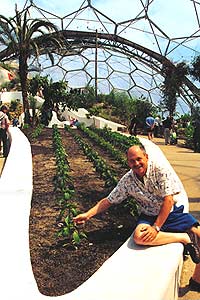 |
The Humid Tropics Biome measures 1,088 feet long, 352 feet wide, and 176 feet high and features plants of the jungles of South America, West Africa, and Malaysia. As we walked along the hot and humid path, we encountered a Malaysian jungle house with a perennial bird pepper plant growing in front of it, plus mini-plantations of poles entwined with black pepper vines (Piper nigrum) and some nice specimens of Piper betle, the pepper used for its leaf, not its berry.
|
|
Piper betle in the Tropics Biome
|
I could have spent two days at Eden, but we only had a few hours, so we didn’t get a chance to visit the extensive outdoor plantings, which reputedly held a secured garden of Cannabis sativa–not a chilli, but another kind of high altogether.
Then it was on to Bath, but we got caught up in the traffic headed toward the huge Glastonbury Festival, an outdoor rock concert attracting more than 100,000 fans, so after we stopped dead in our tracks and didn’t move for twenty minutes, Pat had to pull out his maps and make some radical detours. Along the way, signs read “Concealed Entrance,” and I was certain that some sort of weird hay cutter would pull out in front of us. But the detour was worth it, for in Bath we were treated to one of the spiciest and most delicious meals of the entire trip at the Eastern Eye
|
|
Interior of the Eastern Eye
|
Indian Restaurant.
Let me set the scene: The restaurant, owned by Shuhan and A.H. Choudhury, is set in an elegant Georgian mansion built in 1824. It has enormous round skylights and a sumptuous interior. And the food! Because Pat is author of the Good Curry Guide, which rates the U.K. curry restaurants, he is quite a celebrity and always an honored guest. As such, he is not allowed to order dinner. The owners always order for him, so that he will always have their premier dishes. This time, the four of us dined on samosas, pastries filled with vegetables; sheek kebab, highly spiced minced lamb grilled in a tandoori oven; dhaka chicken roll, marinated and fried chicken; and chicken hariyali, a Nepalese dish also cooked in a tandoori oven. Those were just the starters.
Then we graduated to chicken jalfrazy, which was sauteed in fresh chilli and tomatoes; Bengali king prawn massalla; chiken tikka massalla, marinated in yoghurt and then barbecued; and ayre tarkari, a Bangladeshi fish served in a very spicy sauce. Those were just the chef’s recommendations.
Served along with all these delicious entrees were the vegetarian accompaniments: navrattan pillau, the nutty and fruity spiced rice; mushroom bhaji (sauteed); eggplant bhaji (also sauteed); and saag ponir, homemade Indian cheese cooked with spinach with a touch of spice and fresh cream. Although the final accompaniment contained no chilli, it was one of the best dishes we tasted that night. For dessert, we were treated to the liqueur called Paan, which is made from the leaf of the Piper genus. Specifically, this pepper leaf is Piper betle, so named because it is used to wrap the betel nut, the mildly euphoric, habit-forming substance that is chewed all over the subcontinent. The liqueur Paan smelled and tasted like an exotic flower. It is a digestive with spiritual values symbolic of love, friendship, and respect. We certainly felt that way after the wonderful feast of Bath.
The Roman Baths, a Palace, and the Banquet at Jaipur
As a tourist site, the Roman Baths at Bath were much better than Stonehenge. Granted, their history is better documented, but there are much better interpretive displays, the audio guides are more complete, and we really got the feeling of how the Romans utilized the baths as a social gathering spot, entertainment complex, and place to dine. The baths have been marvelously restored, and the hot water supplying them comes from the same hot springs the Romans used more than 2,000 years ago.
|
|
Roman Baths
|
We jumped ahead in time when visiting Blenheim Palace in Witney, the birthplace of Winston Churchill and the current home of the 11th Duke of Marlborough. The palace construction was stared in 1705 and completed thirty years later. Now, it consists of stately buildings with an extensive art collection and library, plus an arboretum, rose gardens, a butterfly house, and 2,100 acres of parkland. It is a symbol of British nobility. Again, we needed at least a day to see it all, but only had hours.
That was because we had to travel to Milton Keynes, one of the few new cities in England (built in the ‘50s) and thus is a grid rather that the more haphazard design of other British cities. Even so, it was the only place on the trip where we got lost because the hotels had minuscule signage and no billboards pointing us in the right direction. But we had no trouble finding Jaipur, the huge and elegant Indian restaurant on one of the main streets.
|
|
Jaipur Restaurant
|
|
Dominque, Pat,
|
|
Jaipur is owned by Mr. Ahad, known simply as Ahad, another person who was on our tour of India with Pat Chapman. He greeted us effusively, ordered up drinks (our choice), seated us, and proceeded to have his waiters bring out a banquet; his choice, of course.. That turned out to be Bengal niramesh, spiced mixed vegetables; aachari ghost, pickled lamb; king prawns; tandoori lamb chops; lamb biryani; tarka dal, yellow lentils with fried garlic; swordfish curry; and lamb shank curry. The banquet was superb–but was it better than the Feast of Bath? I’ll be diplomatic and say they were both equal and superior to most of the dishes we were served in India.
On to Turkey in Cambridge, Malaysia in Yoxford, and the Ferry in Harwich
Pat was compelled to take us to his Alma Mater, Cambridge University, and we spent a delightful day touring the colleges of King’s, John’s, Magdalene, and Fitzwilliam, where Pat graduated. Parking was a problem because if the parking meter expires, you a liable for a fine of 40 pounds (US$60). But, we lucked out and were able to find on-street parking despite the fact that the town was filled with parents attending their sons’ and daughters’ graduation. We ate lunch at the Anatolia Turkish Restaurant on Bridge Street, and the food was tasty but bland until Pat asked from their red chilli sauce, which made everything better. The Turkish baklava, a nut and honey pastry in filo dough, was different from the Greek version because it used pistachios instead of pine nuts, but just as tasty.
We motored on to the little town of Yoxford in Suffolk, where Chris and Chiu Blackmore own a combination bed and breakfast (seven rooms) and Malaysian restaurant. The Satis House, as it’s called, dates from the early 1800s and Charles Dickens was a friend of the family who owned the house between 1812 and 1878. In Great Expectations, Dickens wrote: “Satis House,” said Pip, “that’s a curious name.” “It’s Greek, Latin, or Hebrew, maybe all three,” she replied. “It means that whoever lives in the house could wish for nothing more.”
|
|
Satis House
|
That was certainly the case for our third former-colony feast. Malaya, of course, was a British colony, and once again we were treated to an example of how the former colonies are heating up the Brits. Under the direction of Chiu, Pat and Dominique, Tony and Jenny Stockman (who also went on the India trip), and Mary Jane and I were treated to appetizers consisting of various satays, skewered meats; pork ribs marinated in plums and hoisin sauce; stir-fried vegetables with garlic; lamb with black pepper, an intensely flavored dish that was fiery hot yet without chillies; and beef penang, a curry like dish that was hot with chillies. Once again the former colony was striking back at the colonial power, and overpowering us with its spices.
Our sixth and final day in England took us to the town on Snape (pronounced “Snipe”), which is the easternmost point in England. So we had traversed the country, west to east, and eaten our way through the former colonies. From Snape, it was a short drive to Harwich, where we would catch the ferry to Cuxhaven, outside of Hamburg, Germany. Pat checked the odometer–we had traveled 1,100 miles through the English countryside! We hugged Pat and Dominique, thanked them for a stimulating and delicious six days, and boarded the ferry for a smorgasbord dinner!
Resources:
Stonehenge: www.savestonehenge.org.uk
Clovelly: www.clovelly.co.uk
Eden Project: www.edenproject.com
Eastern Eye Restaurant: www.easterneye.co.uk
Roman Baths at Bath: www.romanbaths.co.uk
Blenheim Palace: www.blenheimpalace.com
Jaipur Restaurant: www.jaipur.co.uk
Satis House: yblackmore@aol.com
Photos by Dave DeWitt & Mary Jane Wilan

